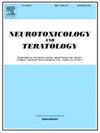Neuroinflammation and oxidative redox imbalance drive memory dysfunction in adolescent rats prenatally exposed to Datura Stramonium
IF 2.6
3区 医学
Q3 NEUROSCIENCES
引用次数: 0
Abstract
Although there have been reports indicating that Datura Stramonium (D. stramonium) may induce anticholinergic and neuropsychiatry effects, the compound is still being used for recreational and medicinal purposes while ingestion during pregnancy has been documented. Intriguingly, minimal studies have investigated the potential neurotoxic impact of D. stramonium exposure at various stages of gestation, including its potential implication on neurophysiological well-being later in life. The present study, therefore, examined spontaneous working memory and the expression of specific neurochemicals modulating crucial neural processes in adolescent rats exposed to high and low D. stramonium doses during different stages of gestation. Pregnant rats were orally infused with 150- or 500- mg/kg/day of D. stramonium either during mid- (second week; days 8–14) or late- (third week; days 15–21) gestation, while control rats received PBS at dosing periods. Behavioral characterization of offspring between postnatal days (PD) 40 and 41 in the Y-maze revealed that D. stramonium perturbed spatial working memory in rats, although locomotor activity was generally unaltered. In addition to SOD and nitric oxide downregulation, induction of oxidative stress in the hippocampus and prefrontal cortex (PFC) of young adult rats prenatally exposed to D. stramonium was corroborated by depletion of key antioxidant regulatory elements glutathione peroxidase, glutathione reductase and catalase, which was accompanied by lipid peroxidation shown by increased MDA levels. Whereas increased expression of acetylcholinesterase and LDH was seen in adolescent rats prenatally infused D. stramonium, acetylcholine levels were downregulated in both hippocampal and PFC lysates, suggesting cholinergic and metabolic dysfunctions. Immunohistochemical labelling of GFAP and IBA-1 revealed increased expression of reactive astrocytes and microglia respectively, while the accompanying TNFα upregulation in both the hippocampus (dentate gyrus) and PFC causally linked intrauterine D. stramonium exposure with neuroinflammatory responses postnatally. Overall, our data correlated postnatal spatial working memory dysfunction evoked by D. stramonium exposure during critical stages of embryonic development to oxidative redox impairment, cholinergic disruption and neuroinflammatory perturbations in rats.
神经炎症和氧化还原失衡导致产前接触曼陀罗的青春期大鼠记忆功能障碍
尽管有报告显示曼陀罗(D. stramonium)可能会诱发抗胆碱能和神经精神作用,但这种化合物仍被用于娱乐和医疗目的,而在怀孕期间摄入这种化合物的情况也有记录在案。耐人寻味的是,很少有研究调查在妊娠不同阶段摄入 D. stramonium 对神经系统的潜在影响,包括对日后神经生理健康的潜在影响。因此,本研究检测了在不同妊娠阶段接触高剂量和低剂量石蒜的青少年大鼠的自发工作记忆以及调节关键神经过程的特定神经化学物质的表达。在妊娠中期(第二周,第8-14天)或后期(第三周,第15-21天),给妊娠大鼠口服150或500毫克/千克/天的D. stramonium,而对照组大鼠在给药期间接受PBS。在 Y 型迷宫中对出生后第 40 和 41 天的后代进行的行为特征分析表明,尽管大鼠的运动活动总体上没有改变,但毒鼠强扰乱了大鼠的空间工作记忆。除了 SOD 和一氧化氮的下调外,产前暴露于石蒜的年轻成年大鼠的海马和前额叶皮层(PFC)中的氧化应激诱导也通过谷胱甘肽过氧化物酶、谷胱甘肽还原酶和过氧化氢酶等关键抗氧化调节元素的耗竭得到了证实,同时还伴随着 MDA 水平升高所显示的脂质过氧化。产前输注石蒜碱的青春期大鼠乙酰胆碱酯酶和 LDH 的表达增加,海马和全脑功能区裂解物中的乙酰胆碱水平下调,表明胆碱能和新陈代谢功能失调。GFAP和IBA-1的免疫组化标记显示,反应性星形胶质细胞和小胶质细胞的表达分别增加,而海马(齿状回)和脑前区伴随的TNFα上调将宫内接触D.总之,我们的数据表明,在大鼠胚胎发育的关键阶段暴露于D. stramonium会诱发其出生后空间工作记忆功能障碍,这与氧化还原损伤、胆碱能干扰和神经炎症扰乱有关。
本文章由计算机程序翻译,如有差异,请以英文原文为准。
求助全文
约1分钟内获得全文
求助全文
来源期刊
CiteScore
5.60
自引率
10.30%
发文量
48
审稿时长
58 days
期刊介绍:
Neurotoxicology and Teratology provides a forum for publishing new information regarding the effects of chemical and physical agents on the developing, adult or aging nervous system. In this context, the fields of neurotoxicology and teratology include studies of agent-induced alterations of nervous system function, with a focus on behavioral outcomes and their underlying physiological and neurochemical mechanisms. The Journal publishes original, peer-reviewed Research Reports of experimental, clinical, and epidemiological studies that address the neurotoxicity and/or functional teratology of pesticides, solvents, heavy metals, nanomaterials, organometals, industrial compounds, mixtures, drugs of abuse, pharmaceuticals, animal and plant toxins, atmospheric reaction products, and physical agents such as radiation and noise. These reports include traditional mammalian neurotoxicology experiments, human studies, studies using non-mammalian animal models, and mechanistic studies in vivo or in vitro. Special Issues, Reviews, Commentaries, Meeting Reports, and Symposium Papers provide timely updates on areas that have reached a critical point of synthesis, on aspects of a scientific field undergoing rapid change, or on areas that present special methodological or interpretive problems. Theoretical Articles address concepts and potential mechanisms underlying actions of agents of interest in the nervous system. The Journal also publishes Brief Communications that concisely describe a new method, technique, apparatus, or experimental result.

 求助内容:
求助内容: 应助结果提醒方式:
应助结果提醒方式:


